|
|
Ny-Ålesund
[78° 55' N 11° 55' E]
By Øystein Overrein (ed.), Jørn Henriksen, Bjørn Fossli Johansen, Kristin Prestvold
Situated at 78º 55' N, Ny-Ålesund is one of the world’s northermost year-round communities. Coal mining was the origin for settlement here, but mining was put to an end after a serious accident in 1962, leaving behind numerous cultural remains of technical and industrial importance. Ny-Ålesund has also been the starting point of several historical attempts to reach the North Pole. Names like Amundsen, Ellsworth and Nobile are strongly linked to Ny-Ålesund. The place has been a centre for tourist operations, with several hotels located in town. Today, 20 000 tourists travelling by cruise ship visit Ny-Ålesund on a yearly basis. Since 1964, Ny-Ålesund has also been a centre for international Arctic research and environmental monitoring. A number of countries run their own national research stations here, and research activity is high in the summer.
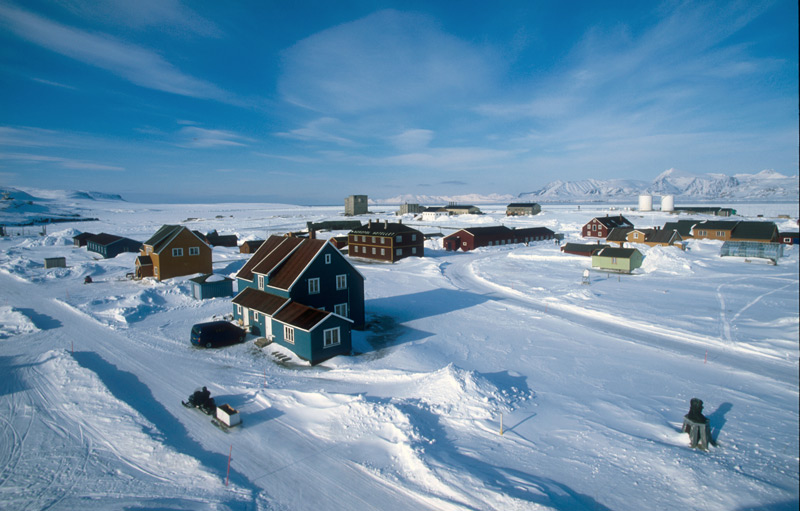 Ny-Ålesund seen from the road to the airport. In the back, the mountains of Tre Kroner, Colletthøgda and Dronningfjella and the glaciers Kronebreen (left) and Kongsvegen (right) may be seen. (Image: Tor Ivan Karlsen / The Norwegian Polar Institute) Take care:
- Ny-Ålesund is a centre for international research. Various ongoing experiments are located just outside the settlement. Visitors are urged to stay on the roads and marked trails. Leave research installations untouched.
- Respect regulations on traffic and follow instructions given on signs.
- Several protected cultural monuments and remains are found in and around Ny-Ålesund, including buildings in the settlement and remains of the coal mining facility. No cultural remains may be removed, disfigured or destroyed.
- Regulations prohibit tenting and campfires in a 100 m security zone around each cultural monument.
- Do not disturb wildlife.
- Respect the local settlement. Do not enter houses without permission.
 The chicken run in Ny-Ålesund in 1939. (Image: Hilda Sommerfeldt / The Norwegian Polar Institute Photo Library) The chicken run in Ny-Ålesund in 1939. (Image: Hilda Sommerfeldt / The Norwegian Polar Institute Photo Library)
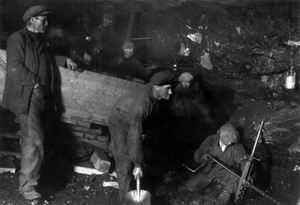 Miners at the coal seam in one of the mines in Ny-Ålesund, 1918. (Image: Sigvald Moa / The Norwegian Polar Institute Photo Library) Miners at the coal seam in one of the mines in Ny-Ålesund, 1918. (Image: Sigvald Moa / The Norwegian Polar Institute Photo Library)
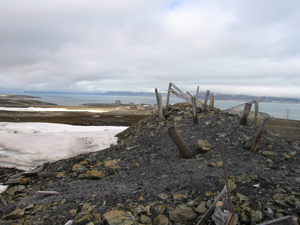 From the mining area of Ny-Ålesund. The settlement is seen in the background. (Image: Mats Hjelle / The Governor of Svalbard) From the mining area of Ny-Ålesund. The settlement is seen in the background. (Image: Mats Hjelle / The Governor of Svalbard)
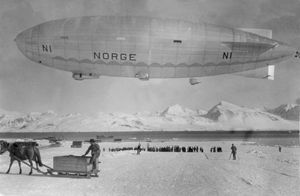 The airship Norge hovers over Ny-Ålesund before heading for the North Pole. (Image: The Norwegian Polar Institute Photo Library) The airship Norge hovers over Ny-Ålesund before heading for the North Pole. (Image: The Norwegian Polar Institute Photo Library)
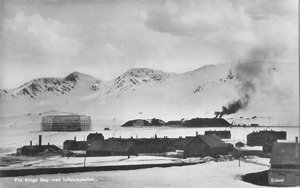 Ny-Ålseund around 1926. In the back – the mines where the dramatic accident in 1962 occured. (Image: Photo Library of the Norwegian Polar Institute) Ny-Ålseund around 1926. In the back – the mines where the dramatic accident in 1962 occured. (Image: Photo Library of the Norwegian Polar Institute)
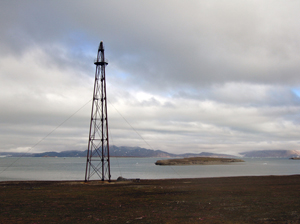 The airship mooring mast in Ny-Ålesund. (Image: Mats Hjelle / The Governor of Svalbard) The airship mooring mast in Ny-Ålesund. (Image: Mats Hjelle / The Governor of Svalbard)
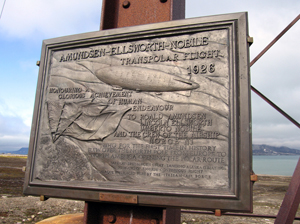 A monument to the successful crossing over the North Pole in 1926 by the airship Norge. (Image: Mats Hjelle / The Governor of Svalbard) A monument to the successful crossing over the North Pole in 1926 by the airship Norge. (Image: Mats Hjelle / The Governor of Svalbard)
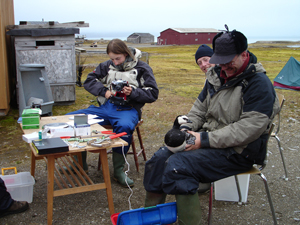 Catching, sampling and marking barnacle geese is a yearly happening in Ny-Ålesund. Most of the adult geese are ringed with metal rings around their feet. (Image: Lise Øvrum / The Governor of Svalbard) Catching, sampling and marking barnacle geese is a yearly happening in Ny-Ålesund. Most of the adult geese are ringed with metal rings around their feet. (Image: Lise Øvrum / The Governor of Svalbard)
 The research station at the mountain of Zeppelinfjellet, just south of Ny-Ålesund. The town and Kongsfjorden are seen in the background. (Image: Tor Ivan Karlsen / The Norwegian Polar Institute) The research station at the mountain of Zeppelinfjellet, just south of Ny-Ålesund. The town and Kongsfjorden are seen in the background. (Image: Tor Ivan Karlsen / The Norwegian Polar Institute)
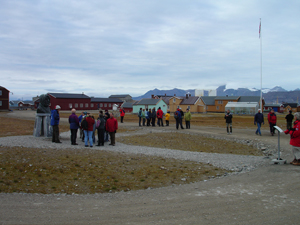 Tourists at the bust of Roald Amundsen, centrally placed in Ny-Ålesund. (Image: Lise Øvrum / The Governor of Svalbard) Tourists at the bust of Roald Amundsen, centrally placed in Ny-Ålesund. (Image: Lise Øvrum / The Governor of Svalbard)
Ny-Ålesund is situated halfway in the fjord of Kongsfjorden, on its south side. As of January 2007, the number of inhabitants was approximately 30. This number rapidly increases to 150 during the summer, when scientists from around 15 countries come to undertake their research. The settlement is made up of some 60 buildings.
The town has both a quay area and an airport. The local museum houses exhibits of Ny-Ålseund’s history from the first establishment of the coal mining facility up to today’s international research community. The world’s northernmost post office is located in Ny-Ålesund, as well as a small café and a souvenir shop.
Ny-Ålesund – a settlement with a dramatic history
The settlement of Ny-Ålesund is strongly linked to coal mining operations, scientific expeditions and recently also to various international research efforts. It is located more than 100 km north of Longyearbyen and is one of the northernmost settlements in the world. In and around Ny-Ålesund is found the largest concentration of protected buildings, cultural monuments and various remains in Svalbard, rendering the place an important cultural heritage site. The cultural history is represented by the town itself, including 30 listed buildings (out of 60 in total), industrial monuments related to the coal mining operations, Roald Amundsen’s airship mooring mast and hangar foundation and some remains of research activities. Ny-Ålesund is the largest Norwegian settlement in Svalbard that was not set fire to during World War II. The settlement is well preserved and worth experiencing, and serves as a valuable historical source.
The mining history of Ny-Ålesund is highly dramatic. The mining settlement was named after Kings Bay Kul Compani (Kings Bay Coal Company – KBKC) located in Ålesund in Norway, which established and operated the mines in Ny-Ålesund. Mining was initiated in 1917. The first period of mining lasted for 12 years until it was closed. However, mining was re-established after World War II, now with the Norwegian authorities as the only shareholder. Optimism, promises for a good future and high demand for coal characterized the years following 1945. Ny-Ålesund was at that time a family community of 200 inhabitants with their own school. In few years, production increased to several tens of thousands of tons of coal, but operations were extremely difficult. The conditions led to a series of severe mining accidents with a high number of fatalities.
To diminish the risk for more serious accidents, the Norwegian authorities began modernizing the mining operations through investments in new facilities after 1953. Modernization and escalation of production were badly timed with the collapse of the world coal marked in 1957. In the years up to 1961, mining investments of 21 million NOK had not yielded a reasonable profit. Continued operations in Ny-Ålesund were questioned.
However, the final collapse of the mining operations and the end of the mining settlement was the great accident on 5 November 1962, which killed 21 miners. Of the 21 bodies, 11 were never retrieved from the mine. In total, 76 people lost their lives in the mines in the years between 1946 and 1962. The last accident precipitated the closing of the mines, and the population in Ny-Ålesund left in 1963. Following the accident and the questions about inadequate safety measures, then-Prime Minister Einar Gerhardsen had to leave his post.
Today, the area stands as a testimony of despair and frustration, but it also constitutes an interesting collection of material remains from 45 years of mining. Most conspicuous are the garish traces of the razing of the mining area. The contours of the mining plant are also still visible.
The mining area, with remains of mining operations and the brutal clearing of the area, may seem like nasty litter, scrap and waste in an otherwise pristine and magnificent natural environment. The mining area is definitively marked by the presence of the remains and represents a considerable intervention in the natural environment. There are obvious reasons for tidying up the area, but the cultural remains tell their story. The area documents and provides insight into a unique and dramatic era of Svalbard’s and Ny-Ålesund’s history and tells the story of people’s destinies and despair. Cultural heritage legislation protects remains from recent human operations as well as very old activities. Many of the remains in the mining area in Ny-Ålesund are therefore automatically protected. The protected cultural remains lie side by side with non-protected remains of less value. Removal of cultural remains requires documentation that the objects are harmful to the environment, for instance removal of wire that can be harmful to animals. The objects in Ny-Ålesund have been evaluated, and the area will stay as it is today, as a monument to people and their activities.
After the closing of the mines, the razing of the mining area and the depopulation of the settlement, Ny-Ålesund rose from the ashes. The Auroral Observatory in Tromsø established a branch here in 1966, and the European Space Research Organisation followed in 1967. The place was re-established in the form of an Arctic research station when the Norwegian Polar Institute initiated permanent research here in 1968. Over the years, Ny-Ålesund has developed into an international outdoor research laboratory. The former mining company, Kings Bay, is active again, now running all infrastructure for the various research groups stationed in and around Ny-Ålesund. Around 30 people overwinter in Ny-Ålesund, whereas in summer the activity rockets sky-high when scientists from all over the world travel to Ny-Ålesund for various fieldwork activities. Ny-Ålesund aims to spearhead in Arctic research and to be a continuously active, international research community in the future.
Ny-Ålesund is also known to be the starting point of Roald Amundsen’s expeditions to reach the North Pole in 1925 with the seaplanes N24 and N25, and in 1926 onboard an airship. In 1926, he succeeded and reached the North Pole with the airship Norge, together with Umberto Nobile from Italy and Lincoln Ellsworth from the US. Ny-Ålesund was also the starting point for Nobile’s dramatic attempt to reach the pole again in 1928 in the airship Italia. On the way back, the Italia crash-landed on the ice, killing half the crew. Nobile was miraculously saved. Roald Amundsen intended to participate in the search for Nobile, but he disappeared with his seaplane Latham after take-off from Tromsø.
Research activity is coordinated by the Ny-Ålesund Science Managers Committee (NySMAC). Ny-Ålesund presents itself to the world as the world’s northernmost, permanent civilian research community, and is today a modern, international base for Arctic research and monitoring in the natural sciences. Several of the research stations in Ny-Ålesund participate in global networks. Since 1998, total person-days of research is about 10 000 on an annual basis.
The following institutions/countries are based in Ny-Ålesund:
- Norwegian Polar Institute – Sverdrup Research Station (established 1968, new building 1999) and Zeppelin Station for Atmospheric Monitoring and Research at the mountain of Zeppelinfjellet at 470 m.a.s.l. (established 1999 in cooperation with the Norwegian Institute for Air Research, new building 2000).
- The Norwegian Mapping Authority – station for satellite geodesy and geo-dynamic studies. Established 1992.
- University of Tromsø – climate facility for experimental plant biology. Established 1987.
- University of Oslo – station for research and education.
- Norwegian Space Centre – launching facility for scientific rockets, SVALRAK, 1997.
- China – Yellow River Station. Research in the fields of atmosphere, northern lights, biology, glaciology, geology and marine biology. Opened 2004.
- France - Rabot-station in Kongsfjorden. Established 1999.
- Germany – Koldewey Station, biological and atmospheric research, run by the Alfred Wegener Institute. Established 1991. Since 2003, the German and French stations have been cooperating closely.
- Great Britain – station for biological research, run by the National Environmental Research Council. Established 1992.
- India – Himadri research station, managed by The National Centre for Antarctic and Ocean Research. Established 2008.
- Italy – Dirigibile Italia Station, run by the Italian Research Council and Institute for Atmospheric Investigations. Established 1997.
- Japan – station for glaciology and climate research, run by the National Institute for Polar Research. Established 1991.
- Kings Bay – Marine Laboratory. Opened 2005.
- South Korea – Dasan Station. Research in the fields of marine biology, geology and physics of the atmosphere. Established 2002.
Tourists have visited Ny-Ålesund since early in the last century. Several cruise ships used to visit the place every year. Over the last decade, cruise ship traffic has sky-rocketed. More than 20 000 tourists visit Ny-Ålesund on a yearly basis and though stays are brief, the tourists definitively mark life in town. In the 1930s, fishing vessels also used to harbour in Ny-Ålesund.
Vulnerable elementsEven though birds in Ny-Ålesund are used to people, visitors should stay on the roads and tracks. Do not feed the Arctic foxes and keep a distance because of the risk of rabies. There is a lot of research activity in town and the surrounding area. Visitors should stay away from research installations. Ny-Ålesund holds many cultural remains, both stationary and loose objects. Enjoy the sight of the cultural monuments. Take pictures, but leave all cultural remains, small and large, untouched. Landing sitesThe harbour in Ny-Ålesund/quay structures.
|
The Cruise Handbook is also available in book form
Order now
Hard cover with numerous pictures - 249 pages - NOK 249.00
Norwegian Polar Institute
Fram Centre
NO-9296 Tromsø
NORWAY
|